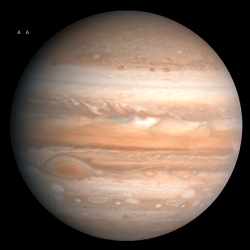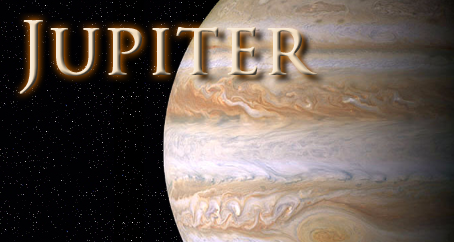Jupiter

Jupiter is the biggest planet in the Solar System and is the first of the four Gas Giants. Earth could fit into Jupiter over 1300 times! The planet has a very strong pull of gravity and very faint rings spinning around it, just like Saturn's rings only much, much thinner. Jupiter is made up almost entirely of gas. This means that the whole planet is just like sky without any land below it. In this sky are electrical storms (lightning) and winds and hurricanes.
Jupiter may have a very small liquid or solid centre which would be only about same size as Earth. This is because the pressure would be so intense at the centre that the atmosphere would feel so 'heavy' at the centre of the planet so that hydrogen molecules (tiny bits of hydrogen) would break down to form a ball of metallic liquid or solid. This metallic core is very dense and is extremely magnetic, causing Jupiter's strong magnetic field. It is this magnetic field that causes Jupiter to create twice as much heat than it receives. and, with the gravitational pull of Europa, Jupiter's second large moon, cause Io, Jupiter's closest large moon, to have the most volcanic surface in the Solar System.
Jupiter's main feature is its Great Red Spot, which is a storm that has been going on for centuries and was first observed by an astronomer called Robert Hooke in 1664! The planet also has an extremely strong magnetic field, extending all the way to the most distant moons of Jupiter. The Sun contains 98% of the matter in the Solar System. About 70% of the rest of the matter is contained in Jupiter! Jupiter is sometimes seen as the Solar System's vacuum cleaner, as its huge size, strong gravitational pull and magnetic field suck up comets, asteroids and meteors hurtling through space which could possibly hit Earth. An example of this was when the comet Shoemaker-Levy collided with Jupiter in 1994.
Some scientists believe that if Jupiter was much bigger, it would be a star. It is made up of the same elements as the Solar System's star, the Sun, hydrogen and helium, plus traces of other elements. Jupiter has a whopping 79 moons known to orbit it. Some of the moons are larger than Pluto and Mercury. The four largest moons, Io, Europa, Ganymede and Callisto, are like four individual worlds, all very different to each other. Io is volcanic, the most volcanic body in the Solar System whereas Europa may have oceans of water under a thick layer of ice! In 1979, two space probes, Voyagers 1 and 2 (USA) reached Jupiter and provided us with detailed pictures of the planet and its moons. These probes also visited the three other Gas Giants (Saturn, Uranus and Neptune) before continuing on to float away through distant space. And, just in case there happened to be any alien spaceships flying past Voyager 1 or 2, both had discs on them containing pictures, maps and charts of Earth and the Solar System and also recordings of sounds and music from Earth. Let's hope the aliens have something to play them on!
